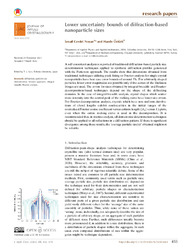Lower uncertainty bounds of diffraction-based nanoparticle sizes
| dc.contributor.author | Noyan, İ. C. | |
| dc.contributor.author | Öztürk, Hande | |
| dc.date.accessioned | 2023-06-22T12:47:56Z | |
| dc.date.available | 2023-06-22T12:47:56Z | |
| dc.date.issued | 2022-06 | |
| dc.identifier.issn | 0021-8898 | en_US |
| dc.identifier.uri | http://hdl.handle.net/10679/8465 | |
| dc.identifier.uri | https://scripts.iucr.org/cgi-bin/paper?S1600576722002564 | |
| dc.description.abstract | A self-consistent analysis is reported of traditional diffraction-based particle size determination techniques applied to synthetic diffraction profiles generated with the Patterson approach. The results show that dimensions obtained from traditional techniques utilizing peak fitting or Fourier analysis for single-crystal nanoparticles have best-case error bounds of around 5%. For arbitrarily shaped particles, lower error magnitudes are possible only if the zeroes of the thickness fringes are used. The errors for sizes obtained by integral-breadth-And Fourier-decomposition-based techniques depend on the shape of the diffracting domains. In the case of integral-breadth analysis, crystal shapes which scatter more intensity into the central peak of the rocking curve have lower size errors. For Fourier-decomposition analysis, crystals which have non-uniform distributions of chord lengths exhibit nonlinearities in the initial ranges of the normalized Fourier cosine coefficient versus column length (|A L | versus L) plots, even when the entire rocking curve is used in the decomposition. It is recommended that, in routine analysis, all domain size determination techniques should be applied to all reflections in a diffraction pattern. If there is significant divergence among these results, the 'average particle size(s)' obtained might not be reliable. | en_US |
| dc.description.sponsorship | TÜBİTAK | |
| dc.language.iso | eng | en_US |
| dc.publisher | Wiley | en_US |
| dc.relation | info:turkey/grantAgreement/TUBITAK/118C268 | |
| dc.relation.ispartof | Journal of Applied Crystallography | |
| dc.rights | Attribution 4.0 International | * |
| dc.rights | openAccess | |
| dc.rights.uri | http://creativecommons.org/licenses/by/4.0/ | * |
| dc.title | Lower uncertainty bounds of diffraction-based nanoparticle sizes | en_US |
| dc.type | Article | en_US |
| dc.description.version | Publisher version | en_US |
| dc.peerreviewed | yes | en_US |
| dc.publicationstatus | Published | en_US |
| dc.contributor.department | Özyeğin University | |
| dc.contributor.authorID | (ORCID 0000-0002-1010-4001 & YÖK ID 295748) Öztürk, Hande | |
| dc.contributor.ozuauthor | Öztürk, Hande | |
| dc.identifier.volume | 55 | en_US |
| dc.identifier.startpage | 455 | en_US |
| dc.identifier.endpage | 470 | en_US |
| dc.identifier.wos | WOS:000810763300002 | |
| dc.identifier.doi | 10.1107/S1600576722002564 | en_US |
| dc.subject.keywords | Diffraction | en_US |
| dc.subject.keywords | Fourier analysis | en_US |
| dc.subject.keywords | Integral breadth | en_US |
| dc.subject.keywords | Particle size determination | en_US |
| dc.subject.keywords | Scherrer approach | en_US |
| dc.identifier.scopus | SCOPUS:2-s2.0-85131749949 | |
| dc.relation.publicationcategory | Article - International Refereed Journal - Institutional Academic Staff |
Files in this item
This item appears in the following Collection(s)
Share this page




